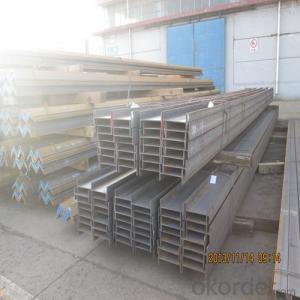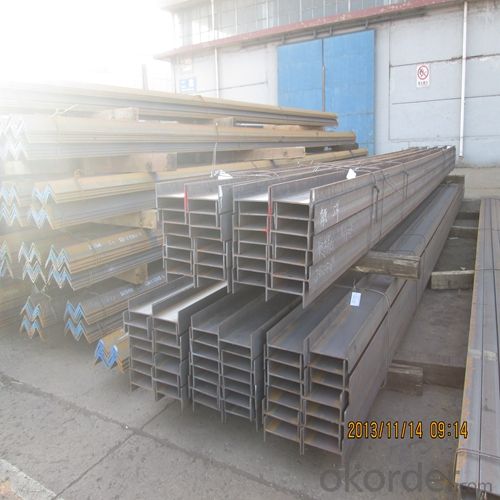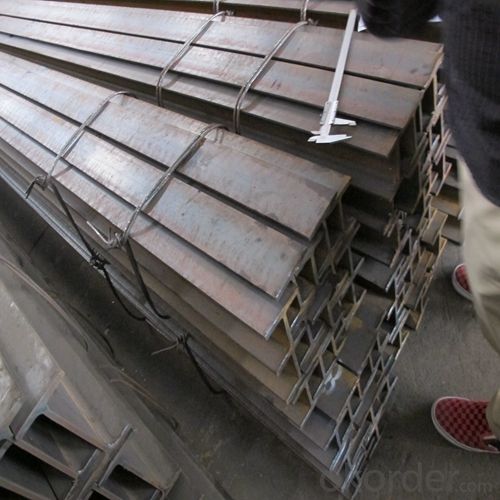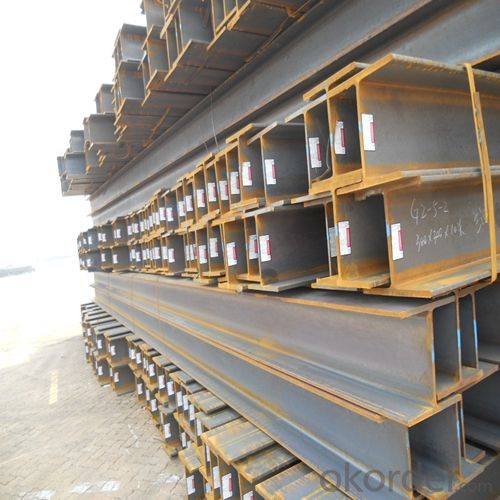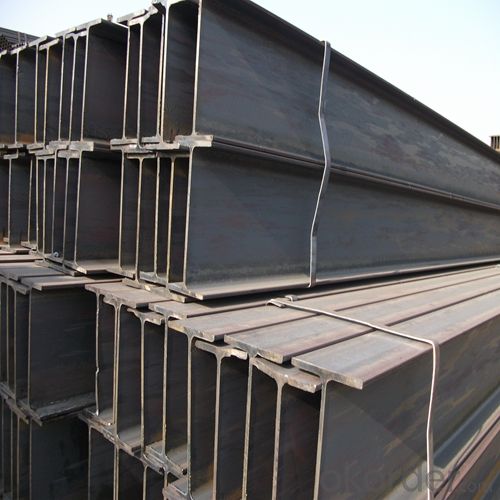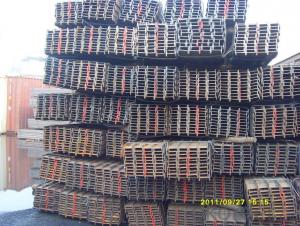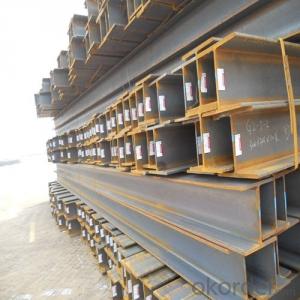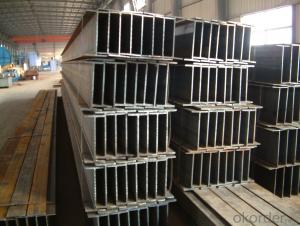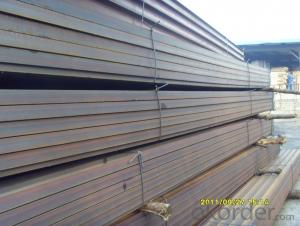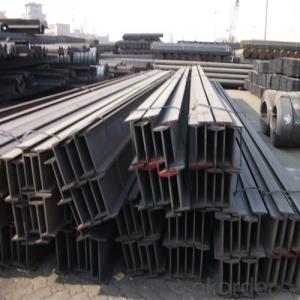Hot Rolled H-Beam Structure Steel Q235 High Quality Good Price
- Loading Port:
- Tianjin
- Payment Terms:
- TT OR LC
- Min Order Qty:
- 500 m.t.
- Supply Capability:
- 5000 m.t./month
OKorder Service Pledge
OKorder Financial Service
You Might Also Like
Product Description:
OKorder is offering Hot Rolled H-Beam Structure Steel Q235 High Quality Good Price at great prices with worldwide shipping. Our supplier is a world-class manufacturer of steel, with our products utilized the world over. OKorder annually supplies products to European, North American and Asian markets. We provide quotations within 24 hours of receiving an inquiry and guarantee competitive prices.
Product Applications:
Hot Rolled H-Beam Structure Steel Q235 High Quality Good Priceare ideal for structural applications and are widely used in the construction of buildings and bridges, and the manufacturing, petrochemical, and transportation industries.
Product Advantages:
OKorder's Hot Rolled H-Beam Structure Steel Q235 High Quality Good Price are durable, strong, and resist corrosion.
Main Product Features:
· Premium quality
· Prompt delivery & seaworthy packing (30 days after receiving deposit)
· Corrosion resistance
· Can be recycled and reused
· Mill test certification
· Professional Service
· Competitive pricing
Product Specifications:
Specifications of Galvanized H beam
1. Invoicing on theoretical weight or actual weight as customer request
2. Length: 6m, 12m as following table
3. Sizes:Zinc Thickness :15-80μ
Model Number | specification | sectional area | theoretical weight | |||
H*B | t1 | t2 | r | kg/m | ||
100*100 | 100*100 | 6 | 8 | 10 | 21.9 | 17.2 |
175*175 | 175*175 | 7.5 | 11 | 13 | 51.43 | 40.3 |
200*200 | 200*200 | 8 | 12 | 16 | 64.28 | 50.5 |
200*200 | 200*204 | 12 | 12 | 16 | 72.28 | 56.7 |
250*250 | 244*252 | 11 | 11 | 16 | 82.05 | 64.4 |
250*250 | 250*250 | 9 | 14 | 16 | 92.18 | 72.4 |
250*250 | 250*255 | 14 | 14 | 16 | 104.7 | 82.2 |
300*300 | 294*302 | 12 | 12 | 20 | 108.3 | 85 |
300*300 | 300*300 | 10 | 15 | 20 | 120.4 | 94.5 |
300*300 | 300*305 | 15 | 15 | 20 | 135.4 | 106 |
350*350 | 338*351 | 13 | 13 | 20 | 135.3 | 106 |
350*350 | 344*348 | 10 | 16 | 20 | 146 | 115 |
350*350 | 344*354 | 16 | 16 | 20 | 166.6 | 131 |
350*350 | 350*350 | 12 | 19 | 20 | 173.9 | 137 |
350*350 | 350*357 | 19 | 19 | 20 | 198.4 | 156 |
400*400 | 388*402 | 15 | 15 | 24 | 179.2 | 141 |
400*400 | 394*398 | 11 | 18 | 24 | 187.6 | 147 |
400*400 | 394*405 | 18 | 18 | 24 | 215.2 | 169 |
400*400 | 400*400 | 13 | 21 | 24 | 219.5 | 172 |
400*400 | 414*405 | 18 | 28 | 24 | 296.2 | 233 |
400*400 | 400*408 | 21 | 21 | 24 | 251.5 | 197 |
400*400 | 428*407 | 20 | 35 | 24 | 361.4 | 284 |
600*200 | 606*201 | 12 | 20 | 24 | 153.3 | 120 |
700*300 | 692*300 | 13 | 20 | 28 | 211.5 | 166 |
700*300 | 700*300 | 13 | 24 | 28 | 235.5 | 185 |
200*150 | 194*150 | 6 | 9 | 16 | 39.76 | 31.2 |
200*175 | 244*175 | 7 | 11 | 16 | 56.24 | 44.1 |
300*200 | 294*200 | 8 | 12 | 20 | 73.03 | 57.3 |
350*250 | 340*250 | 9 | 14 | 20 | 101.5 | 79.7 |
400*300 | 390*300 | 10 | 16 | 24 | 136.7 | 107 |
450*300 | 440*300 | 11 | 18 | 24 | 157.4 | 124 |
500*300 | 482*300 | 11 | 15 | 28 | 146.4 | 115 |
500*300 | 488*300 | 11 | 18 | 28 | 164.4 | 129 |
600*300 | 582*300 | 12 | 17 | 28 | 174.5 | 137 |
600*300 | 588*300 | 12 | 20 | 28 | 192.5 | 151 |
600*300 | 594*302 | 14 | 23 | 28 | 222.4 | 175 |
FAQ:
Q1: Why buy Materials & Equipment from OKorder.com?
A1: All products offered byOKorder.com are carefully selected from China's most reliable manufacturing enterprises. Through its ISO certifications, OKorder.com adheres to the highest standards and a commitment to supply chain safety and customer satisfaction.
Q2: How do we guarantee the quality of our products?
A2: We have established an advanced quality management system which conducts strict quality tests at every step, from raw materials to the final product. At the same time, we provide extensive follow-up service assurances as required.
Q3: How soon can we receive the product after purchase?
A3: Within three days of placing an order, we will begin production. The specific shipping date is dependent upon international and government factors, but is typically 7 to 10 workdays.
Images:

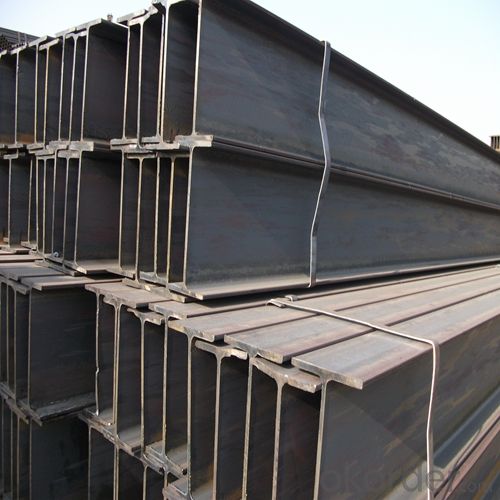
- Q: Are Steel H-Beams resistant to termite or insect damage?
- Steel H-beams are resistant to termite or insect damage. They differ from wooden beams in that they do not offer a source of nourishment for termites or other insects, thus making them highly resistant to infestation. Through the combination of iron and carbon, steel beams are created, which do not allure or sustain termite colonies. This resistance to termite or insect damage serves as one of the numerous benefits of incorporating steel H-beams into construction projects, guaranteeing the beams' structural solidity and long lifespan.
- Q: Can steel H-beams be used in the construction of museums and art galleries?
- Yes, steel H-beams can definitely be used in the construction of museums and art galleries. Steel H-beams are known for their strength and durability, making them suitable for supporting heavy loads and withstanding structural stresses. These beams provide excellent structural support, allowing for large open spaces and flexible layouts within the museum or art gallery. Moreover, steel H-beams can be fabricated to various sizes and lengths, providing versatility in design and construction. Additionally, the sleek and modern aesthetic of steel beams can also complement the overall architectural style and design of the museum or art gallery. Overall, steel H-beams are a popular choice in the construction industry due to their strength, durability, and versatility, making them an ideal material for use in museums and art galleries.
- Q: How do steel H-beams perform in areas with high humidity and chemical exposure?
- Steel H-beams are known for their exceptional strength and durability, making them a popular choice for various structural applications. However, when it comes to areas with high humidity and chemical exposure, there are a few factors to consider. In general, steel is highly resistant to humidity and can withstand prolonged exposure without significant degradation. The H-beams' design, with its wide flanges and thick web, contributes to their resistance against moisture and corrosion. The flanges act as a protective barrier, preventing direct contact between the steel and the surrounding environment. Additionally, the steel used in H-beams is typically coated with a protective layer, such as galvanized or painted coatings, further enhancing its resistance to humidity and chemicals. However, it is important to note that prolonged exposure to high humidity and certain aggressive chemicals can still have an impact on the performance of steel H-beams. In extremely corrosive environments, the protective coating may deteriorate over time, leaving the steel vulnerable to rust and corrosion. This can weaken the structural integrity of the beams and compromise their performance. To mitigate these risks, regular maintenance and inspections are essential. In areas with high humidity and chemical exposure, it is recommended to implement a robust maintenance plan that includes periodic cleaning, inspection for any signs of corrosion, and reapplication of protective coatings as needed. Additionally, using stainless steel H-beams instead of carbon steel ones can provide even greater resistance to corrosion in such environments. In summary, while steel H-beams generally perform well in areas with high humidity and chemical exposure, proper maintenance and inspection are crucial to ensure their long-term durability. By implementing a proactive maintenance plan, the structural integrity of the beams can be preserved, ensuring their continued performance in challenging environments.
- Q: What does H steel column H300*250*6*10-90 represent in steel structure?
- H300*250*6*10 indicates that the welded composite H type steel has a web height of 300, web thickness 6, flange width 250, flange thickness 10, and the units are mm.
- Q: Can Steel H-Beams be used in hotel or hospitality construction?
- Yes, Steel H-Beams can be used in hotel or hospitality construction. They provide structural stability and load-bearing capacity, making them suitable for supporting heavy loads over large spans. Additionally, steel beams offer flexibility in design and can be easily integrated into various architectural styles.
- Q: What are the considerations when designing for acoustical isolation of Steel H-Beams?
- When designing for acoustical isolation of Steel H-Beams, there are several important considerations that need to be taken into account. Firstly, the mass of the steel beams plays a significant role in determining the level of acoustical isolation. Heavier beams tend to have better sound insulation properties due to their increased mass, which helps to absorb and block sound waves. Therefore, it is crucial to select the appropriate size and weight of H-Beams to achieve the desired level of acoustic isolation. Secondly, the structural design of the H-Beams can impact acoustical isolation. The shape and dimensions of the beams, as well as their connection details, need to be carefully designed to minimize sound transmission. Special attention should be paid to any potential flanking paths, where sound can travel through alternate routes such as wall cavities or other structural elements. These flanking paths should be identified and effectively addressed to ensure optimal acoustical isolation. Additionally, the use of appropriate insulation materials is essential for enhancing acoustical isolation. Insulation materials, such as resilient pads or rubber gaskets, can be placed between the steel beams and adjacent elements to reduce the transfer of sound vibrations. The selection and installation of these materials should be done in accordance with industry standards and guidelines to achieve maximum effectiveness. Moreover, the overall construction and assembly process should be carefully managed to avoid any compromises to acoustical isolation. Proper sealing and caulking of joints and connections between the steel beams and other building components are critical to prevent sound leakage. Attention should also be given to the installation of any penetrations through the steel beams, such as pipes or conduits, as these can create weak points for sound transmission if not properly addressed. Lastly, it is important to consider the specific requirements and regulations for acoustical isolation in the intended application or building. Different industries and building codes may have specific standards or criteria that need to be met. Consulting with acoustical engineers or specialists can provide valuable insights and guidance in ensuring compliance with the necessary acoustic isolation requirements. In conclusion, designing for acoustical isolation of Steel H-Beams involves considering factors such as mass, structural design, insulation materials, construction processes, and regulatory requirements. By carefully addressing these considerations, optimal acoustical isolation can be achieved, minimizing sound transmission and enhancing the overall acoustic performance of the building or structure.
- Q: How do steel H-beams perform in heavy snow loads?
- Steel H-beams are commonly used in the construction industry due to their excellent strength and load-bearing capacity. When it comes to heavy snow loads, steel H-beams perform exceptionally well. The design of H-beams allows them to distribute weight evenly across their length, making them ideal for withstanding heavy loads such as snow accumulation. The shape of the H-beam provides a high moment of inertia, which helps to minimize deflection and ensure structural stability under heavy snow loads. Additionally, steel H-beams have a high tensile strength, which enables them to resist bending and deformation caused by the weight of the snow. This strength ensures that the beams can withstand the pressure exerted by the snow without compromising the structural integrity of the building or infrastructure. Furthermore, steel H-beams are highly durable and resistant to corrosion, making them suitable for long-term use in areas prone to heavy snowfall. The steel's ability to withstand harsh weather conditions, including extreme cold and moisture, ensures that the H-beams maintain their structural properties even in snowy environments. Overall, steel H-beams are an excellent choice for heavy snow loads. Their strength, load-bearing capacity, and durability make them a reliable option for supporting structures under the weight of snow, providing stability and safety in areas prone to heavy snowfall.
- Q: Can steel H-beams be used for mezzanine floors?
- Yes, steel H-beams can be used for mezzanine floors. Steel H-beams are commonly used in construction projects, including mezzanine floors, due to their high strength and load-bearing capacity. They provide excellent support and stability, making them an ideal choice for creating additional floor space in industrial or commercial buildings.
- Q: Can steel H-beams be used in data center or server room construction?
- Yes, steel H-beams can be used in data center or server room construction. Steel H-beams are commonly used as structural support in construction projects due to their high strength and durability. In data center or server room construction, where stability and load-bearing capacity are crucial, steel H-beams can provide the necessary strength to support heavy equipment and infrastructure.
- Q: Can steel H-beams be used in marine or coastal environments?
- Yes, steel H-beams can be used in marine or coastal environments. However, it is important to consider the potential challenges posed by corrosion due to saltwater exposure. Proper protective coatings or materials like stainless steel should be used to prevent corrosion and ensure the longevity of the H-beams in such environments. Regular maintenance and inspections are also crucial to identify any signs of corrosion and address them promptly.
Send your message to us
Hot Rolled H-Beam Structure Steel Q235 High Quality Good Price
- Loading Port:
- Tianjin
- Payment Terms:
- TT OR LC
- Min Order Qty:
- 500 m.t.
- Supply Capability:
- 5000 m.t./month
OKorder Service Pledge
OKorder Financial Service
Similar products
Hot products
Hot Searches
Related keywords
